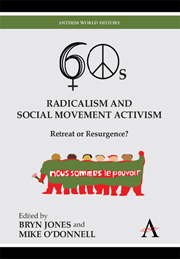Book contents
- Frontmatter
- Contents
- Introduction Sixties Radicalism: Creating Spaces and Leaving Legacies
- PART I Radical Movements Around the World
- 1 All Along the Watershed: Sixties Values as Defence of Community Lifeworlds in Britain 1968–2008
- 2 May's Tensions Today: France, Then and Now
- 3 The War Against the War: Violence and Anticolonialismm, in the Final Years of the Estado Novo
- 4 From Sartre to Stevedores: The Connections between the Paris Barricades and the Re-emergence of Black Trades Unions in South Africa
- 5 1968 – Was it Really a Year of Social Change in Pakistan?
- PART II Theoretical & Cultural Significance
- PART III Social Movement Legacies
- Conclusion
- Notes on Contributors
- Author Index
- Subject Index
2 - May's Tensions Today: France, Then and Now
from PART I - Radical Movements Around the World
Published online by Cambridge University Press: 05 March 2012
- Frontmatter
- Contents
- Introduction Sixties Radicalism: Creating Spaces and Leaving Legacies
- PART I Radical Movements Around the World
- 1 All Along the Watershed: Sixties Values as Defence of Community Lifeworlds in Britain 1968–2008
- 2 May's Tensions Today: France, Then and Now
- 3 The War Against the War: Violence and Anticolonialismm, in the Final Years of the Estado Novo
- 4 From Sartre to Stevedores: The Connections between the Paris Barricades and the Re-emergence of Black Trades Unions in South Africa
- 5 1968 – Was it Really a Year of Social Change in Pakistan?
- PART II Theoretical & Cultural Significance
- PART III Social Movement Legacies
- Conclusion
- Notes on Contributors
- Author Index
- Subject Index
Summary
Introduction: Contested Legacies
On 15 March 1968 France's most important newspaper, Le Monde, published an editorial by Pierre Viansson-Ponté, its chief political writer, entitled ‘France is bored’ (Viansson-Ponté 1968). The author, a former member of the Resistance and one of the country's most respected political commentators, bemoaned the fact that France was ‘removed from the convulsions reshaping the world’, a place where ‘nothing is happening’. He observed in passing that a few students were demonstrating at Nanterre University for the right of female students to enter the male dormitories, dismissing this as ‘despite everything, a limited conception of human rights’. Anyone familiar with French political culture can understand why he would attach so little importance to what was happening at Nanterre. This was at a new university, poorly resourced (the buildings were not even completed), on the edge of Paris’ suburbs, not even serviced by the Metro system. France's intellectual life was centred on the Sorbonne and the Ecole Normale, the cafés of the Latin Quarter, not a new campus on the edge of town. And in France, politics was organized by political parties; its language was political ideologies. Complaints about dormitories were hardly the thing that ‘convulsions reshaping the world’ are made of. Yet a week after Viansson-Ponte's article those same students would occupy Nanterre's administration building, creating what they called the ‘Movement of 22 March’.
- Type
- Chapter
- Information
- Sixties Radicalism and Social Movement ActivismRetreat or Resurgence?, pp. 23 - 38Publisher: Anthem PressPrint publication year: 2010

